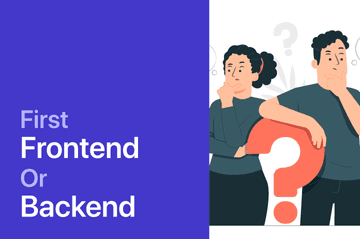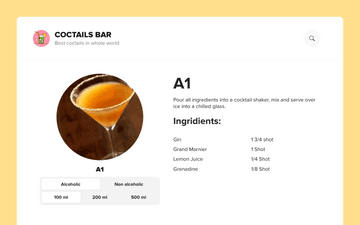Should You Learn Frontend or Backend Development First?
When starting your web development learning journey, it is quite normal to have doubts about the best choice between frontend and backend development.
In this article, we will look at the ins and outs of each option, and by the end of this post, you will have a clear picture of which option is best for you.

Get the latest frontend development resources delivered straight to your inbox for free.
Explore our latest issue for a sample.
🚀 The Complete Web Developer in 2024
Web development is like running a restaurant by yourself. It urges you to be the server who charms the customers (frontend development) and the chef who cooks delicious food (backend development) at the same time.
If you want the customers to enjoy an unforgettable dining experience, you’ll have to perfect both these roles before opening the restaurant. The same goes for building a website.
But where should you start? Should you train to become the server or the chef first? Should you learn frontend or backend development first? Which order will give you a gentler, more exciting learning experience?
Since I haven’t had any luck being a restauranteur yet, I can’t confirm it’ll be the same for a restaurant. When learning web development, however, the clear winner is frontend development. Why? Because it allows you to get a complete overview of the field while building tangible, functional websites.
Frontend vs. backend development—what is the difference?
Frontend and backend, together, form a website.
Just like a server at a restaurant, the frontend focuses more on the user-facing side of the website. It runs on the user’s browser and comes with an intuitive interface designed to give users the best experience. It knows how to communicate with the user, take their input, and deliver the requested results in style.
But the frontend doesn’t produce most of these results on its own.
It leaves that job in the hands of the backend instead. It’s where the actual “cooking” happens.
The backend handles the website’s business logic to prepare the requested data for the user. It runs on a distant server with more processing power and resources than a browser to bear such responsibilities. In this context, the frontend is an intermediate communicator between the user and the backend for relaying requests and returned information.
The differences between the backend and frontend are many, even though the line that separates them is sometimes blurry. Nevertheless, there’s enough contrast between the two to single out frontend as the better choice for getting started with web development for newbies.
Frontend development gives you visible, motivating outcomes
What excites most people about learning web development is getting to build actual websites with cool interfaces and features. The unit responsible for developing these visible and tangible parts is the frontend.
A website with only a backend is not that different from a command-line program. No matter how far you go with its improvements, you can only give the bare bone outputs for the user’s requests.
You won’t get to build a “website” in a traditional sense, with all the eye-catching and user-friendly interfaces, until you move to frontend development.
A frontend is what converts a backend output that looks like this:
{
"idDrink": "17222",
"strDrink": "A1",
"strDrinkAlternate": null,
"strTags": null,
"strVideo": null,
"strCategory": "Cocktail",
"strIBA": null,
"strAlcoholic": "Alcoholic",
"strGlass": "Cocktail glass",
"strInstructions": "Pour all ingredients into a cocktail shaker, mix and serve over ice into a chilled glass.",
"strDrinkThumb": "https://www.thecocktaildb.com/images/media/drink/2x8thr1504816928.jpg",
"strIngredient1": "Gin",
"strIngredient2": "Grand Marnier",
"strIngredient3": "Lemon Juice",
"strIngredient4": "Grenadine",
"strMeasure1": "1 3/4 shot ",
"strMeasure2": "1 Shot ",
"strMeasure3": "1/4 Shot",
"strMeasure4": "1/8 Shot",
"strCreativeCommonsConfirmed": "No",
"dateModified": "2017-09-07 21:42:09"
}Into something like this:

If building such functional websites is what excited you to give this field a try, you should definitely start learning the frontend first. Otherwise, it won’t take you long to see web development as a process that goes nowhere and lose your motivation.
Frontend development alone can’t support all the complex features you may want to include, like user registration. But it has enough functionality to model or mimic many dynamic behaviors of web pages. The visual evidence it provides of your progress also becomes an important source of motivation that inspires your future learning.
If you choose frontend as your introduction to web development, you’ll have more reasons to love the backend when you eventually get there. You’ll know how to connect the advanced functionality it brings with the frontend to make them useful.
You’ll get a better overall idea about the web development process
Learning frontend development can show you the big picture of web development. It helps you understand how different components and technologies come together to create a single website, even before you fully realize how the backend works.
- Building the web frontend teaches you the unique roles HTML and CSS play when creating page elements.
- It shows you how Javascript can be used to listen and respond to user events.
- You also learn how to dynamically add or remove content from the page by manipulating the DOM.
Frontend even provides a workaround to the lack of a backend with the help of third-party APIs. You can use them as pseudo-backends to understand how the actual ones fit into this workflow. They allow you to request and receive data to build web pages that satisfy real user needs and wants.
If you want to take a step further, you can build an entire website without using a backend. In this scenario, you’ll have to use third-party APIs to perform traditionally backend-bound tasks like user authentication, database access, and heavy computations.
On the other hand, if you learn the backend first, you’ll be blind to the workflow on the frontend. It can leave you without a clear idea of how the web development process fits together even after months of studying and practicing.
The frontend learning path is more straightforward for beginners
The frontend roadmap at the beginner level is relatively straightforward. It primarily involves three chores:
-
Defining page structure
-
Styling page elements
-
Making the page interactive
The technologies used for performing these chores are very predictable: HTML, CSS, and Javascript, respectively.
Everyone who enters frontend development understands that these three are the only technologies they have to learn at this level. It doesn’t leave much room for variables that confuses beginners when deciding where to go next.
The landscape of backend development is entirely different than this. There are dozens of languages to choose from, each with several popular frameworks that simplify the development process.
When you move beyond the core language to other components—like databases and deployment servers—there is even more variety in the choices you can make.
This diversity is a positive when it comes to building websites in the real world. But it can easily confuse and overwhelm beginners who don’t have the experience to decide what works best in their situations.
The frontend’s simplicity doesn’t stay that way as you advance further. But at the beginner level, it gives you an easier-to-follow learning path to get started.
Takeaway
The frontend and the backend are the two main components that make up a website. One runs exclusively on the end user’s browser, while the other uses remote servers. From the get-go, they represent two ends in web development that use different approaches to manage relationships with users and deliver outputs.
This inherent difference between the two forces you to ask an essential question when starting with web development. Should you learn frontend or backend development first?
As the process, takes you closer to building programs resembling actual websites, it makes more sense to use frontend development as the starting point.
With the first-hand insight, it can provide into the functions of a website, you’ll have an easier time transitioning to the backend if you start here.